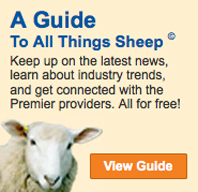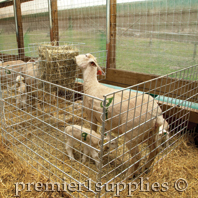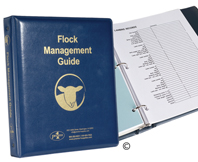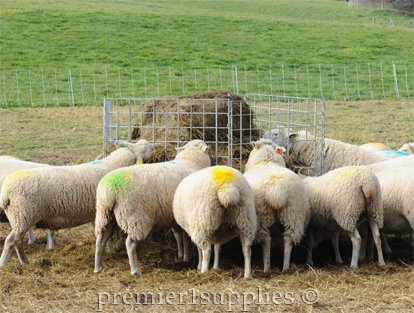
LAMBING JUGS

A typical lambing jug at Premier. Jugs allow the ewe to form a strong bond with her offspring in a controlled environment.
Lambing jugs using Premier's Wire Panels
Select height (PowerBilt® panels 36" or 48" tall or our Standard 40" panels) according to your animals’ behavior (wild vs relaxed, athletic vs calm) and your preferences (tall vs short).
We use connector hinges or braided nylon cord to tie jugs together and Snap Clips as latches.
For more information on lambing jugs, check out this post from our Premier Farm Diary.
ORGANIZING THE FLOCK
 Premier's Flock Management Guide
Premier's Flock Management Guide
Prepared by the folks at Premier in response to requests from shepherd customers. Very efficient and timesaving.
Sections inside include feeding, lambing, shearing, wool sales and info, lamb inventories and sales, breeding, record keeping and health, with relevant tips and space for your notes.
Contains the following record-keeping sections:
| • |
Sheep Calendar Year |
| • |
Flock Health Records |
| • |
Sheep Inventories and Sales |
| • |
Feed Usage |
| • |
To keep domestic dogs in. |
| • |
Annual Precipitation |
| • |
Lambing Records |
| • |
Feeder Lamb Records |
| • |
Shearing/Wool Information |
| • |
Information/References |
Click here to see Premier's complete line of educational books and resources.
|
 |
 |

Feeding the flock with a Big Bale Feeder. When our pastures have ceased being productive, we switch over to feeding baleage. Ewes in the photo have been bred (colored marks). ElectroNet 9/35/12 in use in the background.
Can the Grazing
Season
be Extended?
We put out our first baleage bales of the season last week. This signifies the changeover from grazing to feeding stored feed. But not all of our flock is out of the pasture—a few ewes are still enjoying late-season grazing. Find out more about how to extend your grazing season to supplement stored feed in the articles below from Virginia Tech and Auburn University.
We've also included an article from Cornell University on direct-marketing lambs. The article focuses on marketing directly to the end consumer and provides helpful advice on developing that venture.
EXTENSION NEWS
Extending grazing and reducing stored feed needs
By Ball, D.M., E.N. Ballard, M.L. Kennedy, G.D. Lacefield, and D.J.Undersander, 2008.
Extending Grazing and Reducing Stored Feed Needs. Grazing Lands Conservation
Initiative Publication 8-01, Bryan,TX.
Why extend the grazing season?
For most livestock producers, extending the grazing season for their animals, or otherwise filling gaps in pasture forage availability to reduce stored feed needs, should be a high priority objective. There are several reasons why this is beneficial:
| • |
Better for the environment. Feeding hay or other stored materials in a barn or other enclosed area concentrates animals, and the manure that accumulates requires expense to remove. Feeding livestock in pastures often results in hoof damage to the land. |
| • |
Weather is less of a concern. Weather is a major concern with hay production, but animals can graze almost without regard to weather. |
| • |
Higher-quality forage leads to better animal performance. The forage quality of young, vegetative pasture growth and even leafy autumn residue is usually considerably higher than that of hay, which is produced by cutting older, more fibrous forage. Consequently, performance is typically better when animals graze properly managed pasture. |
| • |
Requires less labor. Less labor is required to have animals graze rather than to provide them with stored feed. In particular, in contrast to feeding stored feed in an enclosed facility, the labor associated with manure removal is avoided. |
| • |
Lowers expenses. Stored feed is almost always two to three times more expensive per animal or per day than pasture. In livestock budgets, stored feed typically accounts for 25% or more of the cost of production, and producer records often reveal it to be higher. The quantity of stored feed required is one of the best indicators of profitability for a livestock operation. In general, the less hay needed, the more cost-efficient the operation. |
Read More »
EXTENSION NEWS
Sheep Grazing Management
By Steven H. Umberger,
Extension Animal Scientist, Sheep, Virginia Tech
Forages constitute 75 to 90 percent of the total diet for sheep. Sheep are excellent converters of forage to meat and fiber and are capable of producing a USDA Choice carcass from forage alone. Sheep consume a wide variety of forages, and selectively graze numerous weeds and other pasture menaces such as multiflora rose and blackberry. Companion grazing of sheep with other species of livestock, such as cattle or goats, results in greater pasture utilization and higher quality pastures than when a single species is grazed alone. Sheep prefer to graze hillsides and steep slopes and provide a means for improving forage utilization and fertility on areas not accessible to farm equipment.
Class and stage of production of the animals dictate the type and quality of forage to be grazed. Lactating ewes with lambs are placed on the highest quality pasture available to promote desired levels of milk production and lamb growth. Dry, non-pregnant ewes or ewes in early to mid-gestation are placed on lower quality forages or serve as second grazers behind young, growing lambs. Strategies that match stage of animal production with type and quality of forage improves overall forage utilization while maintaining optimum animal performance.
Although year-round grazing programs are not attainable in most parts of Virginia, the combined use of permanent and annual forages can come within four to six weeks of a year-round supply of non-harvested feed. Strategic allocation of pasture forages through the use of controlled grazing provides a tool by which producers can lengthen the grazing season and improve overall forage utilization per unit of land area. The advent of high tensile electrified wire and electrified temporary fence has made the application of controlled grazing economical, practical, and profitable.
Read More »
ON-FARM MARKETING TIPS
Direct On-Farm Marketing of Slaughter Lambs and Goats
By Tatiana Stanton, April 2013
(Cornell Small Ruminant Extension Specialist)
Originally written for The Goat Farmer in 2000,
but substantially updated in 2013
There are many ways to market lambs and slaughter goats in the Northeast US. One method is to forgo middlemen and instead market your live animals directly from your farm to consumers. Direct on-farm marketing can be time consuming and stressful depending on how many of its inherent responsibilities you end up assuming. However, it's also a great chance to meet new folks and learn about a diverse range of cultures and ethnic groups.
Before you attempt direct marketing, you need to determine what size and age lamb or goat kid makes the most sense for you to raise based on 1) what consumer demand is in your area and 2) what the costs of production and expected returns are to grow animals out for each category. You also need to understand what additional responsibilities and expenses you may incur when selling animals directly to consumers. This article outlines some of the duties involved in on-farm marketing.
By "direct on-farm marketing" I refer to two different scenarios, each operating under a different set of legal requirements. In the first scenario, the customers come to the farm and pick out an animal for their family's consumption, and either slaughter the animal at the farm or load it in their vehicle to slaughter elsewhere. The animal does not need to be slaughtered under USDA federal inspection because the activity falls under the "personal use exemption" 9 CFR 303.1(a)(1) which allows the owner of an animal to slaughter the animal themselves if it is for consumption only by them and their family and friends.
The second scenario is the standard "freezer trade" where a customer orders an animal to be picked out for them and delivered to a slaughterhouse for slaughter and processing according to their cutting instructions for consumption by their family and friends. The customer does not necessarily have to see the animal in advance but should have communicated directly with you when placing the order for an animal. In this case the animal does not necessarily have to be slaughtered under USDA federal inspection but can instead be slaughtered at a custom exempt slaughterhouse under the "custom exemption" 9 CFR 303.1(a)(2). You can transport the animal to the slaughterhouse as a service for the new owner.
Depending on the clientele in your local area, you may not have much choice as to which of these scenarios you get involved with. Rather, your clientele may have a strong preference for only one method of direct marketing. Your ability to conform to their needs may determine whether on-farm direct marketing is going to work for you.
Read More »
|
|